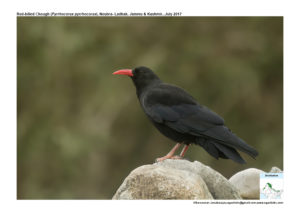Red-billed Chough

Red-billed Chough Pyrrhocorax pyrrhocorax
Etymology:
- Pyrrhocorax : Greek word purrhos -flame-coloured, red; korax – raven
- Pyrrhocorax : Greek word purrhos -flame-coloured, red; korax – raven
Vernacular Names: Persian, Baluchistan: Zagh, Kash: Wan kavin, Wozij tonti kavin, U.P.: Kangni, Lepcha: Chumboo
Distribution in India: Resident of Upper Himalayas
Description: Size of 38–41 cm; wt. of 207–375 g. It is a medium-sized, relatively small-headed and short-legged corvid with comparatively long, slim and gently decurved bill with tip of upper mandible slightly overlapping lower. In flight, it has broad wings prominently “fingered”, distinctly buoyant and bounding flight often interspersed with tumbling, swooping and diving, or soaring and gliding. The nominate race has entire body plumage glossy blue-black, glossed greenish on wings and tail; iris is dark brown; bill is scarlet; legs are bright red. Both the sexes are similar. The juvenile has a duller plumage , less glossy, black than adult’s, bill is shorter and initially dull orange, becoming red by first autumn, legs are dusky to pinkish, becoming red by first autumn. The races differ mainly in intensity of plumage gloss and overall size, coastal races generally smaller than mountain forms, the nominate is smallest. The race himalayanus ( North East India) is largest race, glossed blue or bluish-purple, is also relatively longer-tailed than most of others; race centralis (Kashmir and Ladakh ) has even longer tail, but is smaller, and has only weak bluish plumage gloss
Habitat:It is found in high mountain pastures with rocky crags. In Himalayas it is found in range 2400–3000 m, but ascends to 6000 m in summer and reported as high as 7950 m on Mt Everest. Found near grazing stock and is attracted to human habitation for nest-sites; forages in grassy areas within towns
Food Habits:It is primarily insectivorous in spring and summer. Larvae beetles caterpillars and ants. Also eats wide variety of other spiders, grasshoppers sometimes even scorpions .In autumn and winter, when invertebrate food more difficult to find, takes grain, seeds and small berries. It forages on ground in open country, typically in pairs or family parties. On ground, hops, walks and runs between bouts of probing or vigorous digging; digging accompanied by wing-flicking and tail-flicking ,digs quite deep pits, tossing soft sand aside and over its back in the process. Turns over dung and small stones in search of invertebrates
Breeding Habits: They breed in April-May. The nest is usually instigated by male, but finished by female, a mass of sticks, thickly lined with wool, rarely all wool, built typically in roof of cave or rock chimney, or disused quarry, roof space of disused building, old mine shaft ,monastery etc. Sometimes excavates a hole in soft sandstone cliff. Lays a clutch of 4-6 eggs, incubation by female alone, fed on nest by male, incubation period is 17–21 days. Chicks fed by both parents, occasionally also by a helper, nestling period 36–41 days; young remain in family group for up to 50 days after fledging.
A peculiar habit observed is that they can turn relatively larger stones by reaching forwards and pulling back with stone against chest. This is done in search of food.